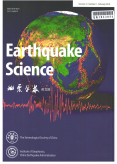- 钛学术文献服务平台 \
- 学术期刊 \
- 基础科学期刊 \
- 天文学、地球科学期刊 \
- 地震学报(英文版)期刊 \
Imaging the rupture process of the 10 January 2018 MW7.5 Swan island,Honduras earthquake
Imaging the rupture process of the 10 January 2018 MW7.5 Swan island,Honduras earthquake
基本信息来源于合作网站,原文需代理用户跳转至来源网站获取
摘要:
The 10 January 2018 MW7.5 Swan island,Honduras earthquake occurred on the Swan island fault,which is a transform plate boundary between the North American and Caribbean plates.Here we back-project the rupture process of the earthquake using dense seismic stations in Alaska,and find that the earthquake ruptured at least three faults(three stages)for a duration of~40 s.The rupture speed for the longest fault(stage 3)is as fast as 5 km/s,which is much faster than the local shear wave velocity of~4 km/s.Supershear rupture was incidentally observed on long and straight strike-slip faults.This study shows a supershear rupture that occured on a strike-slip fault with moderate length,implying that supershear rupture might commonly occur on large strike-slip earthquakes.The common occurrence of supershear rupture on strike-slip earthquakes will challenge present understanding of crack physics,as well as strong ground motion evaluation in earthquake engineering.

推荐文章
2018年印度尼西亚帕鲁MW7.5地震构造背景与区域地震活动
摩鹿加海微板块
太平洋板块
印度尼西亚
苏拉威西岛
海啸
单分散铁基Fe60Ni7.5Mo7.5P10C10B5金属玻璃球形粒子的制备及评价
脉冲微孔喷射法
铁基金属玻璃
单分散粒子
冷却速率
An experimental study on dynamic coupling process of alkaline feldspar dissolution and secondary min
Alkaline feldspar
Dissolution rate
Precipitation
Mineral conversion
Secondary porosity
10 MW高温气冷堆屏蔽计算分析
高温气冷堆
屏蔽计算
TORT程序
MCNP程序
内容分析
关键词云
关键词热度
相关文献总数
(/次)
(/年)
引文网络
引文网络
二级参考文献 (0)
共引文献 (0)
参考文献 (10)
节点文献
引证文献 (0)
同被引文献 (0)
二级引证文献 (0)
1973(1)
- 参考文献(1)
- 二级参考文献(0)
1986(1)
- 参考文献(1)
- 二级参考文献(0)
1991(1)
- 参考文献(1)
- 二级参考文献(0)
2002(1)
- 参考文献(1)
- 二级参考文献(0)
2012(1)
- 参考文献(1)
- 二级参考文献(0)
2013(2)
- 参考文献(2)
- 二级参考文献(0)
2016(1)
- 参考文献(1)
- 二级参考文献(0)
2017(1)
- 参考文献(1)
- 二级参考文献(0)
2019(1)
- 参考文献(1)
- 二级参考文献(0)
2020(0)
- 参考文献(0)
- 二级参考文献(0)
- 引证文献(0)
- 二级引证文献(0)
引文网络交叉学科
相关学者/机构
期刊影响力
地震学报(英文版)
主办单位:
中国地震学会
出版周期:
双月刊
ISSN:
1674-4519
CN:
11-5695/P
开本:
16开
出版地:
北京民族学院南路5号(北京8116信箱)
邮发代号:
创刊时间:
1980
语种:
eng
出版文献量(篇)
1366
总下载数(次)
0
总被引数(次)
3070
期刊文献
相关文献
推荐文献
- 期刊分类
- 期刊(年)
- 期刊(期)
- 期刊推荐
力学
化学
地球物理学
地质学
基础科学综合
大学学报
天文学
天文学、地球科学
数学
气象学
海洋学
物理学
生物学
生物科学
自然地理学和测绘学
自然科学总论
自然科学理论与方法
资源科学
非线性科学与系统科学
地震学报(英文版)2022
地震学报(英文版)2021
地震学报(英文版)2020
地震学报(英文版)2019
地震学报(英文版)2018
地震学报(英文版)2017
地震学报(英文版)2016
地震学报(英文版)2015
地震学报(英文版)2014
地震学报(英文版)2013
地震学报(英文版)2012
地震学报(英文版)2011
地震学报(英文版)2010
地震学报(英文版)2009
地震学报(英文版)2008
地震学报(英文版)2007
地震学报(英文版)2006
地震学报(英文版)2005
地震学报(英文版)2004
地震学报(英文版)2003
地震学报(英文版)2002
地震学报(英文版)2001
地震学报(英文版)2000
地震学报(英文版)1999

 免费查重
免费查重










